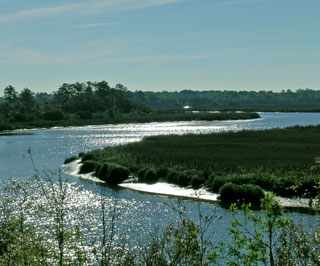Marine - Salt Marsh Habitat
 The intertidal area between high tide and low tide provides a huge transitional zone for both aquatic and terrestrial animals, as well as for those plants capable of withstanding regular inundation of their roots by brackish water.
The intertidal area between high tide and low tide provides a huge transitional zone for both aquatic and terrestrial animals, as well as for those plants capable of withstanding regular inundation of their roots by brackish water.
South Carolina's 344,500 acres of salt marsh, the most of any state on the east coast, make up two-thirds of the state’s coastal wetlands, greatly increasing habitat for aquatic organisms and for the transfer of plant production into animal matter.
The salt marsh acts somewhat like a river flood plain, except that the flooding, while much more regular and predictable, lasts only a few hours each day, greatly altering the behavior of fishes and invertebrates that live in, or venture into, this dynamic habitat. Some fish, like the southern flounder, enter the salt marsh during these high tides to feed, while others like the spotted seatrout stay to the edges.
A myriad of small, meandering creeks flood and drain the marsh on each tide. The larger and deeper of these creeks contain water even at low tide so that the marsh and adjacent estuarine waters form an inter-woven system.
Salinity varies widely with the height of the tide and with rainfall. Heavy rains increase freshwater runoff from upland streams; droughts allow ocean water to encroach farther inland. This variability in salinity requires species living here to be able to tolerate wide salinity ranges. Some fish juveniles are able to tolerate this variability in salinity, such as tarpon, black drum and red drum.
Incoming freshwater carries a heavy load of silt which fertilizes the marsh soil but can smother plants and interfere with the respiration of marsh animals. Silting produces a very soft marsh substrate known as "pluff mud."
The dominant marsh plant, cord grass, or spartina, with plenty of sunlight and no competition, produces a huge amount of organic matter annually. While not eaten directly, the marsh grass breaks down into an organic soup called detritus. The small invertebrates that feed on detritus begin a food chain that extends to top predators, both aquatic and terrestrial.
However, the rapidly changing environment from wet to dry, hot to cold, and fresh to salt limits the number of animals that can inhabit the marsh permanently. Those that have adapted to this harsh environment, such as mussels, oysters, periwinkles, barnacles, blue crabs and fiddler crabs, take advantage of the abundant nutrients and often develop large populations.
Three-quarters of all the animals harvested as seafood in South Carolina, even offshore species such as some groupers, spend all or part of their lives in the salt marsh and its tidal creeks, making this unique habitat critical to the coastal environment.
